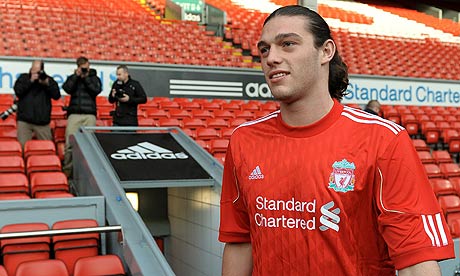As soon as last season was over, one specific English club was more active in the transfer window than, perhaps, on the field throughout the season. From John O’Shea to Sergio Aguero, Liverpool have been linked with virtually every player on the lookout for a new club.
However, when the club’s new owners decided to take a plunge into the transfer window, carrying their little money-bearing bags – little compared to the likes of Man City – they had a clear strategy in mind. The priority was towards signing young players, British players or players with Premier League experience. All over the news, Liverpool were said to be ‘going English’, although, to be fair, it was more of ‘going British’; the two terms being heavily merged since Scottish tennis star Andy Murray’s rise.
The hunt for young British players was a refreshing sight for Liverpool supporters. The supporters had felt a distinct lack of young, exuberant English flavor at the club for a long time. But with the record signing of 22 year-old English forward Andy Carroll, the acquisition of 18 year-old Jonjo Shelvey and with successful first-team stints of English players from the academy like Jay Spearing, John Flannagan and Jack Robinson, the English essence seemed to have been returning to the club.

Suddenly, a club that had been relying on the heavy shoulders of the aging Steven Gerrard could be seen walking on its own feet and not only without wobbly legs, but with a bit of a swagger in its step.
Although much of the transfer strategy has been attributed to the homegrown-player ruling and financial fair-play, there is more to it than just this. One of the keys to success in the English Premier league over the past decade has been an English (or British) backbone. John Terry and Frank Lampard have typified this at Chelsea. So have the likes of Rio Ferdinand, Gary Neville, Paul Scholes, Ryan Giggs and now, Wayne Rooney at Manchester United. In fact, at Old Trafford, the list goes on with the likes of Phil Neville, Michael Carrick and Darren Fletcher. The reason for United’s high-tempo game throughout the past decade can be attributed to a constant British feel to the club.
Even Manchester City’s and Tottenham’s English players are of vital importance to the club. Arsenal are, perhaps, the only exception that haven’t really seen an English pillar in the recent past; a reason for the team’s lack of robustness when it has mattered most.
Liverpool have been linked with 26 year-old Scottish midfielder Charlie Adam, 27 year-old English winger Stewart Downing and 18 year-old English striker Connor Wickham among other players. 20 year-old English midfielder Jordan Henderson has already been signed, while 25 year-old winger Ashley Young and 19 year-old stalwart defender Phil Jones have already been lost to Old Trafford. It is pretty clear that at the end of this transfer window, Liverpool will certainly have more than a couple of new, young British signings with a view towards long-term employment and stability.
![Young,_Ashley[c]wikimedia commons](http://www.thehardtackle.com/wp-content/uploads/2011/05/Young_Ashleycwikimedia-commons.jpg)
But are Liverpool’s British signings likely to work judging by past trends at the club? Are these signings any different from the previous British signings?
Let’s roll back to the treble season of 2001 when Liverpool won the UEFA Cup (now UEFA Europa League), FA Cup and the Carling Cup in addition to finishing a respectable 3rd in the league. Liverpool had plenty of British players for main-team contention at the start of the season. Although it is true that British players were large in number during that era, but even for those times, the club had plenty of British players.
Jamie Carragher, Steven Gerrard and Michael Owen had come through the ranks of the academy and played major roles in the club’s triumphs. 22 year-old English forward Emile Heskey, 26 year-old English midfielder Nick Barmby and 36 year-old experienced Scottish midfielder Gary McCallister had also arrived at the club. These players arrived for the 2000-01 season to add to the great English servants already present in the squad in the form of legendary striker Robbie Fowler and midfielders Jamie Redknapp and Danny Murphy.
The 2000-01 season is remembered to be the last time Liverpool achieved grand success on all fronts. Of course, the year of Istanbul cannot be forgotten but apart from the Champions League victory – no doubt, a huge thing – Liverpool finished fifth and were humiliatingly knocked out of cup competitions in the 2004-05 season.
Record-signing Emile Heskey’s first season at Liverpool was a success, but beyond that, he became the butt of most jokes, one of the most heavily criticized strikers and a great disappointment. Nick Barmby was another signing that did not work out well for the club and he left Liverpool two seasons later. The following years saw 20 year-old English goalkeeper Chris Kirkland arrive at the club, but he could never cut it to become number one choice at the club. English keeper Scott Carson’s case was hardly different.

Worryingly, though, Heskey and Barmby were signed as proven stars in the Premier League, while the two goalkeepers were an inexperienced gamble that did not pay off.
In the next few seasons, 24 year-old lanky English striker Peter Crouch, 22 year-old English winger Jermaine Pennant and 27 year-old Welsh striker Craig Bellamy arrived at the club for moderately successful stints that bordered on disappointments. Peter Crouch was signed for diversity in the front-line and linked up extremely well with Steven Gerrard. Although his time at Liverpool was turbulent, he was never expected to yield a lot of goals and these low expectation levels meant his time at Liverpool could be considered a moderate success.
Jermaine Pennant arrived as an Arsenal reject and failed to make significant impact at the club, while Craig Bellamy arrived as an experienced Premier League player and did not particularly set the world alight at Liverpool, either. Again, signings that were supposed to have enough Premier League experience did not quite work out in the end.
In the last couple of seasons, 25 year-old (now almost 27) English right-back Glenn Johnson has been a reasonably successful addition to the club, showcasing flexibility and versatility in positions and formations. Signing of 29 year-old left-back Paul Konchesky has turned out to be a disaster, but not a bigger one than the signing of 29 year-old English midfielder Joe Cole. All three were signed due to their experience in English football rather than youth players for the future.
And finally, it is too early to provide a verdict on 18 year-old English midfielder Jonjo Shelvey and 22 year-old record signing English forward Andy Carroll. While the former is likely to be loaned out to a club before the start of next season, the latter hasn’t shown early signs of justifying his monstrous price tag.
Worryingly for Liverpool supporters, only two of Liverpool’s British signings over the last decade can really be considered good one and even these signings haven’t quite set the world on fire at Anfield. The lesson to be learned is that Liverpool’s successful English presence at the club was due to its academy and not due to its checkbook.
Now, Liverpool are again gambling on British transfer targets and the supporters seemed to have drowned in the wave of optimism, overlooking the poor record over the last decade. Perhaps, the optimism should not exceed a certain threshold level. Understandably, though, there is plenty of hopefulness due to three major reasons.
First, the club is gambling on young talents that have already starred in the Premier League and have experience at the highest level; something that hasn’t worked in the past, but the comparison of talent shows that today’s targets are better than targets at a similar age in the past.
Second, there is hope and belief that Kenny Dalglish’s presence at the club will help mould the new signings into the ‘Liverpool way of life’. This is extremely crucial since the new signings will soon be, hopefully, stepping onto the field with graduates from the academy; ones who have Liverpool running in their blood.
![Dalglish [C] Wikimedia](http://www.thehardtackle.com/wp-content/uploads/2011/03/Dalglish-C-Wikimedia.jpg)
And third, the supporters definitely have more faith in King Kenny’s judgment than managers in the recent past. Gerard Houllier wasn’t required to make much British signings since Liverpool’s youth academy supplied plenty of talent. Rafa Benitez preferred foreign players and the lesser said about Roy Hodgson’s signings, the better.
So, although there is plenty of reason to be cheerful at the club, the supporters must not get carried away with the potential British signings. Past trends suggest that the development of the likes of Robinson, Flannagan and Spearing should be greater sources of optimism than the signings of Henderson, Adam and other potential newcomers.
King Kenny is known to spot talent – Alan Shearer – and break trends – Blackburn’s Premier League title. Under his reign, the expectations have certainly grown.
However, rather than somewhere else, let’s hope that we don’t have to look any further than home.
——————–
Follow us on twitter @TheHardTackle




